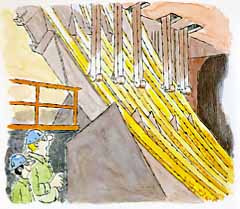


At our Aliquippa Works we have a machine that makes blooms and billets directly from molten steel without the need to make ingots first. Strand casting (also called continuous casting") is a fairly recent addition to steelmaking technology.
Our strand casting machine is 19 stories tall. Molten steel is carried to the top in large ladles and poured into water-cooled molds. Six continuous strands of steel, either of bloom or billet dimensions, are drawn out of the bottom of the molds.
When each strand emerges from the mold, its outer surface is solidified, but its inner core is still molten. As the strand travels downward, away from the mold, water sprays help solidify it throughout. Solidification is complete by the time the strand reaches the bottom of the machine (above).
A system of guide rolls bends the vertical strand horizontal and straightens it. Then, it's cut into blooms or billets of convenient length by a shear or a torch.
Strand casting is a valuable technique for manufacturing certain kinds of steel that are not easy to roll into billets using the traditional blooming mill method.
Though strand casting sounds simple, it can be a tricky process to control. Operators must work hard to prevent "blow outs" of the strand's thin solidified surface. A blow out will allow molten steel to pour out of the inner core.
J&L recently developed a device that improves the quality of strand cast steel. It's called the Pollard Shroud, and it is designed to protect the stream of molten steel that flows into the mold.
The Pollard Shroud keeps oxygen in the atmosphere
away from the molten steel (above). This prevents the formation
of undesirable chemical compounds within the steel. J&L is
making Pollard Shroud technology available to other steel companies.